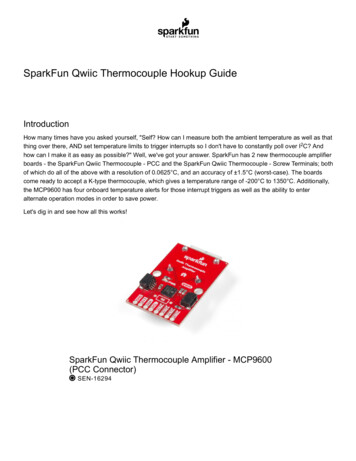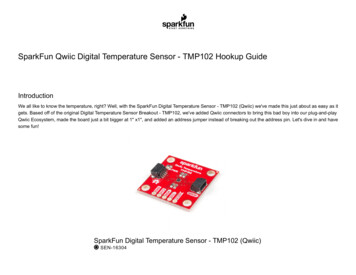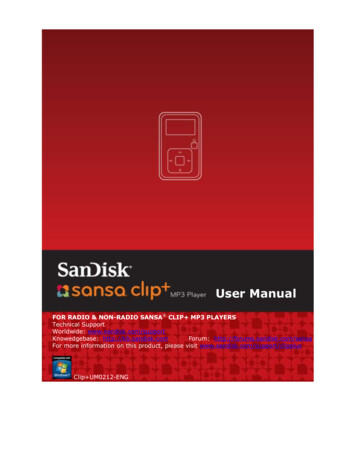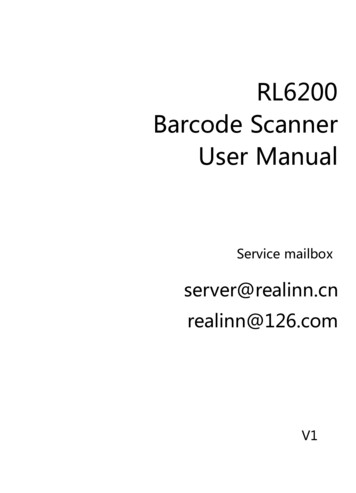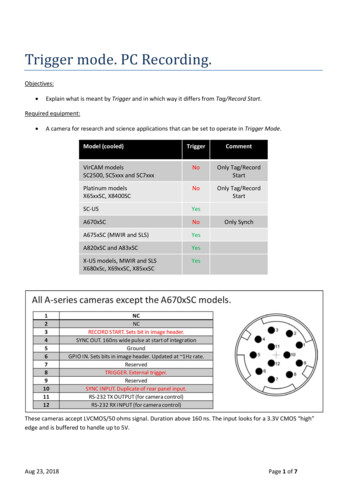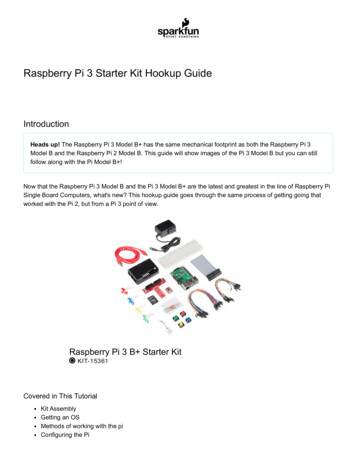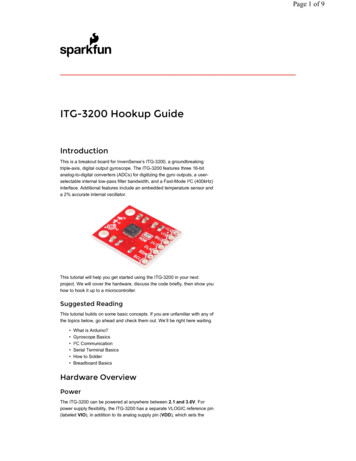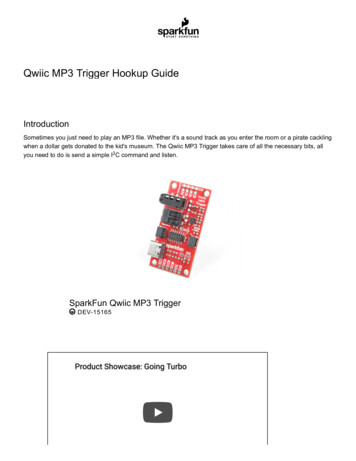
Transcription
Qwiic MP3 Trigger Hookup GuideIntroductionSometimes you just need to play an MP3 file. Whether it's a sound track as you enter the room or a pirate cacklingwhen a dollar gets donated to the kid's museum. The Qwiic MP3 Trigger takes care of all the necessary bits, allyou need to do is send a simple I2C command and listen.SparkFun Qwiic MP3 Trigger DEV-15165Product Showcase: Going Turbo
Required MaterialsThe Qwiic MP3 Trigger does need a few additional items for you to get started, shown below. However, you mayalready have a few of these items, so feel free to modify your cart as necessary.USB Wall Charger - 5V, 1A (Black)Hamburger Mini Speaker TOL-11456 COM-14023USB 2.0 Cable A to C - 3 FootmicroSD Card - 1GB (Class 4) CAB-15092 COM-15107Note: If you want to add hardware connections for the triggers, you will probably some soldering equipment,hook-up wire, and some momentary buttons. Additionally, if you wish to interface with the board using amicrocontroller, you should also grab a RedBoard Qwiic and some Qwiic cables.Suggested ReadingIf you’re unfamiliar with switches, jumper pads, or I2C be sure to checkout some of these foundational tutorials.
Logic LevelsSwitch BasicsLearn the difference between 3.3V and 5V devices andlogic levels.A tutorial on electronics' most overlooked andunderappreciated component: the switch! Here weexplain the difference between momentary andmaintained switches and what all those acronyms (NO,NC, SPDT, SPST, .) stand for.I2CHow to Work with Jumper Pads and PCB TracesAn introduction to I2C, one of the main embeddedcommunications protocols in use today.Handling PCB jumper pads and traces is an essentialskill. Learn how to cut a PCB trace, add a solderjumper between pads to reroute connections, andrepair a trace with the green wire method if a trace isdamaged.The Qwiic Keypad utilizes the Qwiic connect system. We recommend familiarizing yourself with the Logic Levelsand I2C tutorials (above) before using it. Click on the banner above to learn more about our Qwiic products.SparkFun's Qwiic Connect System
Hardware OverviewElectrical CharacteristicsThe Qwiic MP3 Trigger is designed to operate at 3.3V and must not be powered above 3.6V as this is themaximum operating voltage of microSD cards. The 5V power from the USB C connector tied to a robust AP21123.3V voltage regulator that can source up to 600mA for the board. Otherwise, the board can also be poweredthrough the Qwiic connector.Maximum Operating VoltagesAll I/O pins are 5V tolerant but the board must but powered at 3.3V.Recommended Operating VoltagesAll I/O pins are designed to function at 3.3V. The board consumes 35mA at 3.3V in standby and can consumeover 400mA when driving at 8 Ohm speaker at max volume.Note: The Qwiic MP3 Trigger can be powered through either the USB C cable or the Qwiic connector whenused in conjunction with the RedBoard Qwiic. However, when using the Qwiic connection make sure that the3.3V line can source enough current for the amplifier.MP3 and ATtiny84At the heart of the Qwiic MP3 Trigger is the WT2003S MP3 decoder IC. This IC reads MP3s from the microSDcard and will automatically mount the SD card as a jump drive if USB is detected. The ATtiny84A receives I2Ccommands and controls the MP3 decoder.SD and USBThe SparkFun Qwiic MP3 Trigger works with 512MB to 32GB cards formatted in FAT32. We recommend theSparkFun 1GB MicroSD Card because it’s a good mix of low-cost and good performance for MP3 playing. Up to255 songs can be loaded onto Qwiic MP3 Trigger.
The easiest way to add and remove MP3s to the Qwiic MP3 Trigger is to attach a USB C cable. This willenumerate the microSD card as a jump drive making it extremely easy to access the files on the card.Alternatively, if you don’t want to use USB, you can eject the microSD card and read/write to it using a normal USBSD adapter.Troubleshooting Tip: While USB is connected to a computer, MP3 playing is disabled. However, as long asD /D- are not connected, you can power the board over USB from a USB wall adapter or power bank andstill use the Qwiic MP3 Trigger normally.Note: If you are moving just a few MP3 files, the USB C cable will work perfectly fine. However, if you need tomove large amounts of data to the SD card, we suggest a normal USB SD adapter. The write speed to theSD card through a USB C cable is slower than a few MBs per second.Qwiic ConnectorsThe Qwiic MP3 Trigger from SparkFun includes two Qwiic connectors to make daisy chaining this music playerwith a large variety of I2C devices. Checkout Qwiic for your next project.The I2C pins broken out on the board are tied directly to the Qwiic connectors.Audio Amplifier
The speaker is boosted by a Class-D mono amplifier capable of outputting up to 1.4W. What does 1.4W mean?It's incredibly loud; great for making sure your mech effects are heard on the *con floor (i.e. Comic - con, Def con, etc.) and wonderful for annoying your officemates. Both outputs have volume controlled by the SET VOLUMEcommand and is selectable between 32 levels. Additionally, there are PTH holes beside both connectors if asoldered connection is preferred.Note: The volume can be adjusted in software using the SET VOLUME 0x07 command (see Command Setsection). The volume setting is saved to NVM (non-volatile memory) and loaded at power on.Audio OutputsA standard 3.5mm audio jack is provided making it easy to play your tunes over headphones or amplified desktopspeakers like our Hamburger Speaker or any other amplifier.A poke-home connector labeled Speaker is also provided in parallel to the 3.5mm jack. This is a friction fit typeconnector; simply push stranded or solid core wire (22AWG or larger) into the hole and the connector will grip thewire.To use an external speaker, solder two wires onto the speaker and insert the wires into the poke home connector.Wire inserted into the poke home connector.
To remove, push down on the tab with a ballpoint pen and gently pull on the wire.Using pen to remove wire from poke home connector.JumpersThe Qwiic MP3 Trigger has three jumpers shown below:The default 7-bit I2C address of the Qwiic MP3 Trigger is 0x37 . The ADR jumper is open be default and can beclosed with solder to force the device’s I2C address to 0x36 . This is handy if you need to have two Triggers on thesame bus. If you need more than two devices on the bus, or if these addresses conflict with another I2C device theaddress can be changed in software. Please see the Command Set.
Troubleshooting Tip: Closing the ADR jumper forces the device to I2C address 0x36 regardless what theuser may have set via the SET ADDRESS command.Cutting the I2C jumper will remove the 2.2k Ohm resistors from the I2C bus. If you have many devices on your I2Cbus you may want to remove these jumpers. Not sure how to cut a jumper? Read here!The INT jumper is located below the SparkFun logo and connects a 10K pull-up resistor to the INT pin. If you havemultiple, open-drain, interrupt pins connected together you may want to remove this pull-up to better control thepull-up resistance.I/O PinsThere are several I/O pins broken out on the board, which are described in the table below.PinNameTypeDescriptionRSTInputActive low. Pull this pin low to reset the ATtiny84A, effectively resetting the Qwiic MP3Trigger.INTOutputActive low. Goes low when track is finished playing. Goes high again whenCLEAR INTERRUPTS command is issued.SCLInputSerial clock line of I2C interface. Qwiic MP3 Trigger does implement clock stretching andwill hold the clock line low if it is unable to receive additional I2C data.SDAInput/Output Serial data line of I2C interface.3.3VPowerQwiic MP3 Trigger can be powered from 2.8V to 3.3V. Anything greater than 3.6V willdamage the microSD card.GNDPowerThe ground pin.Trigger Input1-4When a trigger pin is pulled to ground, the corresponding T00X.mp3 file is played. Pinscan be combined to play T001 to T010. Pins are 5V tolerant.TriggersThere are four trigger pins at the top of the board. When pulled low these pins begin playing whatever file isnamed T001.mp3 to T010.mp3 . For example, if you attach a momentary button to Pin 3 and GND, when youpress that button the T003.mp3 file will immediately be played. This allows you to start playing sound effects withthe touch of a button without any programming!
Single TriggerFor a basic triggered setup, load four files named T001.mp3, T002.mp3, T003.mp3, and T004.mp3 on themicroSD card. Use a wire or button to connect a trigger pin to ground and the associated track will begin playing.Once you have the setup working, use any momentary button to allow a user to cause an MP3 to start playing.Using Multiple TriggersBy pulling multiple pins down simultaneously the four triggers can play up to ten tracks: T001 to T010. When atrigger pin is detected the pin values are added together. For example, pulling pins 2 and 4 low at the same timewill play track T006.mp3 as will pulling pins 1, 2, and 3 low at the same time.Note:The trigger pins are constantly monitored and any change in pins will immediately cause the new trackto begin playing.Indefinitely holding a pin low will cause the same track to play again. This allows for looping soundeffects.Interrupt PinThe Qwiic MP3 Trigger has an INT pin which is configured as an open-drain pin with an on board 10K Ohm pullup.The INT pin will go low when a track has stopped playing. Once the CLEAR INTERRUPTS 0x0D command hasbeen received, the INT pin will become high-impedance and will return to a high level.If you have multiple devices with bussed interrupt pins you may want to cut the INT jumper to remove the 10Kpull-up resistor.Qwiic MP3 Trigger LibraryNote: This section assumes you are using the latest version of the Arduino IDE on your desktop. If this isyour first time using Arduino, please review our tutorial on installing the Arduino IDE. If you have not
previously installed an Arduino library, please check out our installation guide.The SparkFun Qwiic MP3 Trigger Arduino library demonstrates how to control all the features of the Qwiic MP3Trigger. We recommend downloading the SparkFun library through the Arduino library manager by searching'SparkFun MP3 Trigger'. Alternatively you can grab the zip here from the GitHub repository:SPARKFUN QWIIC MP3 TRIGGER ARDUINO LIBRARY (ZIP)Once you have the library installed checkout the various examples.Example1: Play the first MP3 track on the microSD card.Example2: Play the next track on the microSD card.Example3: Play a particular file. For example mp3.playFile(3); will play F003.mp3.Example4: Stop and pause tracks.Example5: Kitchen sink example showing setting of volume, equalizer, get song name, get song count, getfirmware version, etc.Example6: Change the I2C address of the MP3 Trigger. Allows multiple Triggers to live on the same I2Cbus.Example7: Shows how to start the library using a different Wire port (for example Wire1).Example8: Demonstrates how to check for the end-of-song interrupt and begin playing the song again.Command SetThe SparkFun Qwiic MP3 Trigger library takes care of all these commands for you. However, if you want toimplement your own interface, the following commands are available (see list below). The Qwiic MP3 Trigger usesstandard I2C communication to receive commands and send responses. By default, the unshifted I2C address ofthe Qwiic MP3 Trigger is 0x37 . The write byte is 0x6E and the read byte is 0x6F .Here is an example I2C transaction showing how to set the volume level to 10:Here is an example I2C transaction showing how to read the device ID (0x39):The following commands are available:STOP 0x00 - Stops any currently playing trackPLAY TRACK 0x01 [TRACKNUMBER] - Play a given track number. For example 0x01 0x0A will play the 10thMP3 file in the root directory.PLAY FILENUMBER 0x02 [FILENUMBER] - Play a file # from the root directory. For example 0x02 0x03 willplay F003.mp3.PAUSE 0x03 - Pause if playing, or starting playing if pausedPLAY NEXT 0x04 - Play the next file (next track) located in the root directoryPLAY PREVIOUS 0x05 - Play the previous file (previous track) located in the root directorySET EQ 0x06 [EQ SETTING] - Set the equalization level to one of 6 settings: 0 Normal, 1 Pop, 2 Rock, 3 Jazz, 4 Classical, 5 Bass. Setting is stored to NVM and is loaded at each power-on.
SET VOLUME 0x07 [VOLUME LEVEL] - Set volume level to one of 32 settings: 0 Off, 31 Max volume.Setting is stored to NVM and is loaded at each power-on.GET SONG COUNT 0x08 - Returns one byte representing the number of MP3s found on the microSDcard. 255 max. Note: Song count is established at power-on. After loading files on the SD card via USB besure to power-cycle the board to update this value.GET SONG NAME 0x09 - Returns the first 8 characters of the file currently being played. Once thecommand is issued the MP3 Trigger must be given 50ms to acquire the song name before it can be queriedwith an I2C read.GET PLAY STATUS 0x0A - Returns a byte indicating MP3 player status. 0 OK, 1 Fail, 2 No suchfile, 5 SD Error.GET CARD STATUS 0x0B - Returns a byte indicating card status. 0 OK, 5 SD Error. Once thecommand is issued the MP3 Trigger must be given 50ms to acquire the card status before it can be queriedwith an I2C read.GET VERSION 0x0C - Returns two bytes indicating Major and Minor firmware version.CLEAR INTERRUPTS 0x0D - Clears the interrupt bit.GET VOLUME 0x0E - Returns byte that represents the volume level.GET EQ 0x0F - Returns byte that represents the EQ setting.GET ID 0x10 - Returns 0x39. Useful for testing if a device at a given I2C address is indeed an MP3Trigger.SET ADDRESS 0xC7 [NEW ADDRESS] - Sets the I2C address of Qwiic MP3 Trigger. For example 0x6E0xC7 0x21 will change the MP3 Trigger at I2C address 0x37 to address 0x21. In this example 0x6E isdevice address 0x37 with write bit set to 1. Valid addresses are 0x08 to 0x77 inclusive. Setting is stored toNVM and is loaded at each power-on.Command QueThe ATtiny84A receives commands over I2C. It then records the I2C commands into a command que. The que issent FIFO over serial to the WT2003S at 9600bps. The WT2003S then requires an undetermined amount of timeto respond. This means that commands are not instantaneously executed by the Qwiic MP3 Trigger and somecommands may require a certain amount of time to before the Qwiic MP3 Trigger has loaded a valid response.An Example GET SONG NAME. Do you know the answer?For example, GET SONG NAME can be issued by the master microcontroller to the Qwiic MP3 Trigger. The QMP3then transmits a serial command to the WT2003S. After a certain amount of time (unfortunately there are no maxtimes defined by the WT2003S datasheet) the WT2003S will respond via serial. This can take 15 to 40ms. At thattime, the song name will be loaded onto the Qwiic MP3 Trigger and can be read over I2C by the mastermicrocontroller.In order to avoid clock stretching by the Qwiic MP3 Trigger and tying up the I2C bus, the Qwiic MP3 Trigger willrelease the bus after every command is received. Therefore, it is up to the user to wait the minimum 50msbetween the WRITE GET SONG NAME and the READ I2C commands.Power Up TimeThe MP3 decoder IC on the Qwiic MP3 Trigger is the WT2003S. It requires approximately 1500ms after power onto mount the SD card. Normally, the Qwiic MP3 Trigger is powered while the user writes and re-writes sketches sothe user does not notice this boot time. The boot time only comes into effect when user initially powers their
project. The main controller (such as an Uno) needs to wait up to 2 seconds before giving up communicating withthe Qwiic MP3 Trigger. The SparkFun Qwiic MP3 Trigger library takes care of the 2 second wait but if you’rewriting your own implementation then consider the following example code:if (isConnected() false){delay(2000); //Device may take up to 1500ms to mount the SD card//Try againif (isConnected() false)return (false); //No device detected}return (true); //We're all setup!Maximum Song CountUp to 255 songs can be loaded onto Qwiic MP3 Trigger and triggered through the command interface.Example 1: Play Track 1The Qwiic MP3 Trigger can be used both as a standalone board or with the Qwiic connect system. In this case, wewill be using the RedBoard Qwiic as the microcontroller in the Qwiic system.For both options, make sure to load an MP3 file labeled T001.mp3 onto the MicroSD card.Heads up! Make sure to follow the same format to label each track when including more than one audio file.Otherwise, you associated audio file will not begin playing with the trigger pin. For example, if you wereincluding a second track, make sure to label it as T002.mp3 to associate it with Trigger Pin 2.Standalone: Using Trigger 1By default the firmware installed on the ATtiny84 allows you to play tracks using the triggers. For more details, seethe Triggers section of the Hardware Overview. Simply plug in the SD card, power the Qwiic MP3 Trigger, andshort the Trigger Pin 1 to GND. Everytime you short both pins, T001.mp3 will play.Triggering the first track to play by shorting Trigger 1 with a pair tweezers. Click on image for a closer view of thehardware setup.Arduino Library: Using RedBoard QwiicPlug in the SD card into the MP3 Trigger. Then, connect the Qwiic MP3 Trigger to the RedBoard Qwiic using aQwiic cable.
Triggering the first track to play through the Qwiic connection. Click on image for a closer view of the hardwaresetup.Upload Example1-PlaySong.ino using the Arduino IDE to the RedBoard Qwiic. Once uploaded, the RedBoard willcheck for the Qwiic MP3 Trigger, set the volume to 10 and then play T001.mp3 . Pressing the RESET button on theRedBoard will run the sketch again.Resources and Going FurtherHave fun with your new tunes maker!For more on the Qwiic MP3 Trigger, check out the links below:Schematic (PDF)Eagle Files (ZIP)WT2003S Datasheet (PDF)Qwiic Landing PageSparkFun Qwiic MP3 Trigger Arduino LibraryExample Sketches (ZIP)Qwiic MP3 Trigger RepoSFE Product ShowcaseNeed some inspiration? Check out some of these related tutorials:MP3 Player Shield Music BoxSound Page GuideMusic Box Project based on the Dr. Who TARDIS.How to use the Lilypad MP3 Player and some BareConductive Paint to make a fandom silhouette soundtrigger page.
Photon Battery Shield Hookup GuideThe Photon Battery Shield has everything your Photonneeds to run off, charge, and monitor a LiPo battery.Read through this hookup guide to get started using it.Check out these other Qwiic tutorials:Qwiic Magnetometer (MLX90393) HookupGuideSparkFun Edge Hookup GuideFigure out how magnetic fields are oriented, all withouthaving to solder a thing.Get to know your Edge board, including both thehardware features for you to utilize as well as how toget talking to it.Advanced Autonomous Kit for Sphero RVRAssembly GuideSparkFun Environmental Sensor Breakout BME680 (Qwiic) Hookup GuideGet your Advanced Autonomous Kit for the SpheroRVR built up with this hookup guide!A hookup guide to get started with the BME680Environmental Sensor from Bosch. Monitor the airquality, temperature, humidity, and barometric pressurewith this Qwiic sensor!Or check out these blog posts:
Enginursday: The Dug CollarThe MP3 Music BoxJULY 12, 2018FEBRUARY 19, 2019Enginursday: The Qwiic JukeboxEnginursday: 3D Printed Harry Potter TalkingHeadAPRIL 4, 2019AUGUST 8, 2019How I Built a Cap Touch Sound Board with theQwiic SystemAUGUST 5, 2020
The SparkFun Qwiic MP3 Trigger works with 512MB to 32GB cards formatted in FAT32. We recommend the. SparkFun 1GB MicroSD Card. because it's a good mix of low-cost and good performance for MP3 playing. Up to 255 songs can be loaded onto Qwiic MP3 Trigger. 2.
